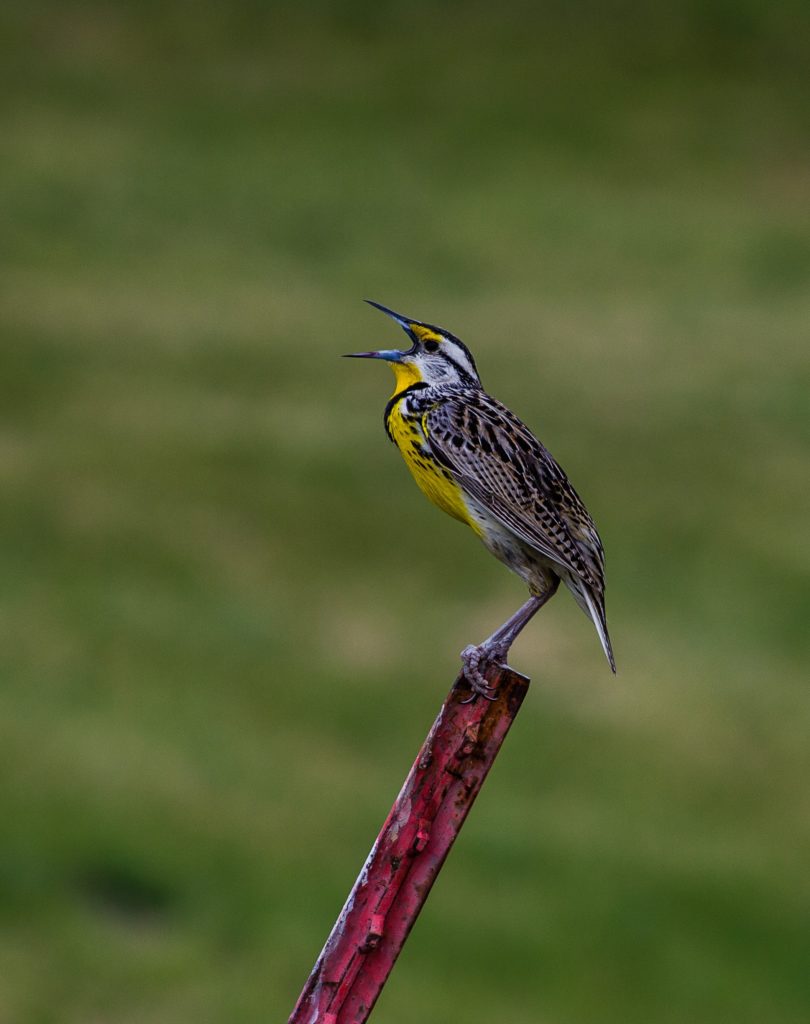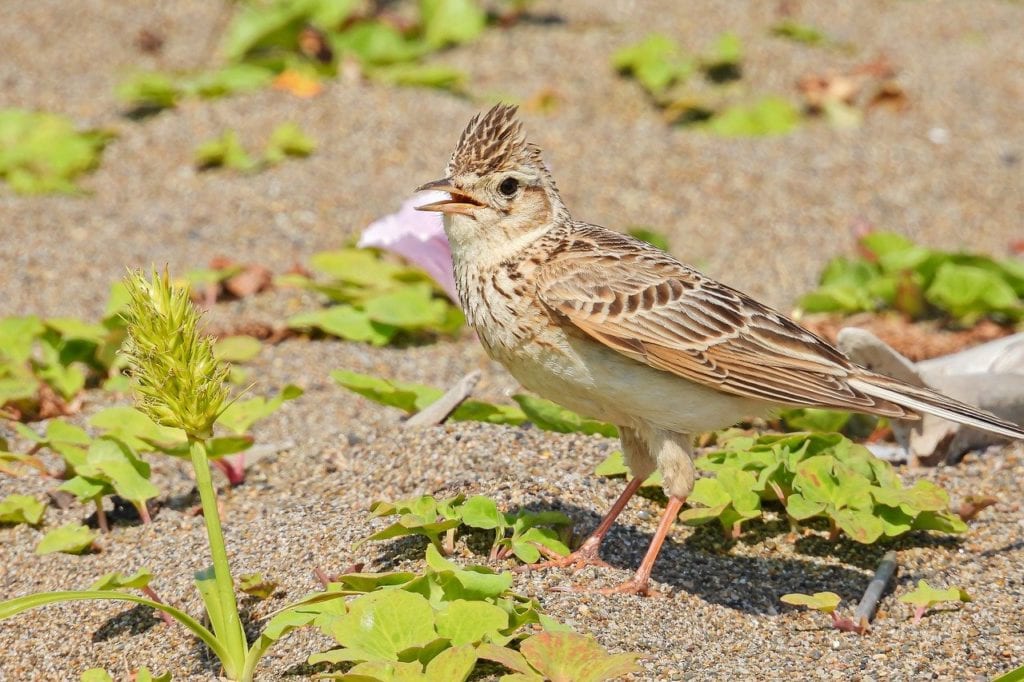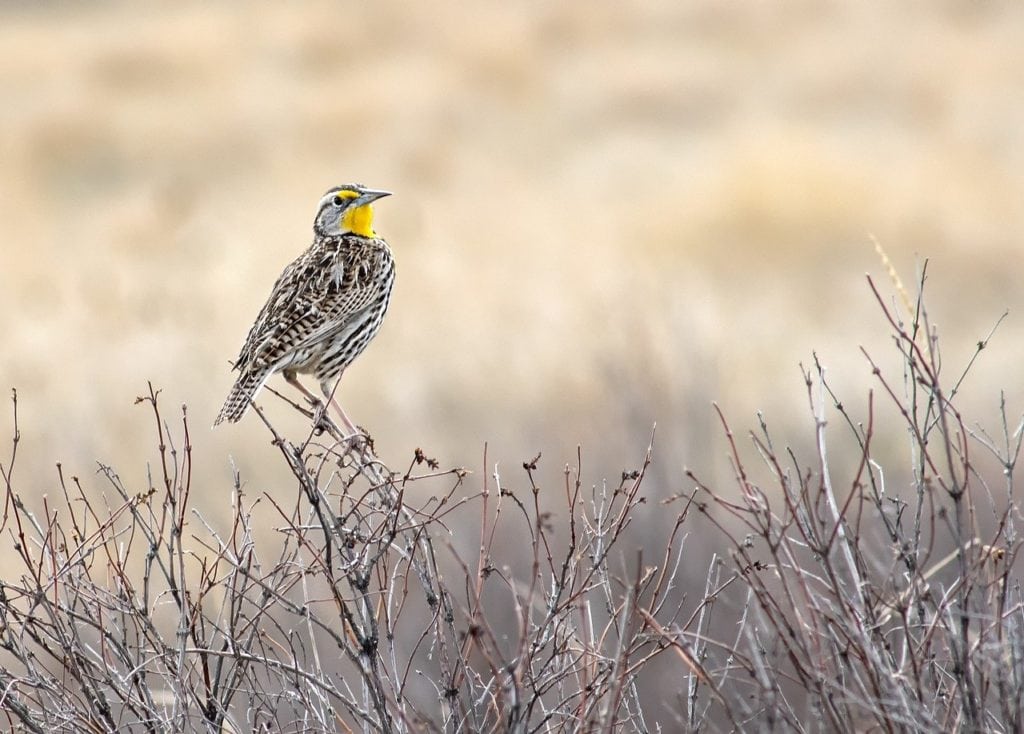There are roughly ninety species of lark which occur throughout the world, with most larks concentrated in Africa and Eurasia. In the United States, only one true lark species exists, however meadowlarks, which are more closely related to blackbirds, are common. This article will include meadowlarks, since they are very important in Native American traditions, however it is definitely worth noting that they are unrelated to true larks.
The lark is a treasured symbol throughout the continents which it inhabits. Associated with daylight, fair weather, and melodious singing, it is easy to see why so many poets have been enamored with this exceptional bird.
Lark Symbolism and Meaning
The lark is prominently associated with the break of day and the start of the spring season. Larks are known for their beautiful contributions to the “dawn chorus” and as such represent hope, light, and joy.
The word “lark” can refer to a fun, spontaneous, or frivolous venture. So, larks are also associated with playfulness and a carefree outlook. Throughout literature, larks appear as symbols of joyous freedom. (1)
Certain species of lark, such as the striking Horned Lark, are known to collect bits of pebbles and random debris which they use to fortify their nests. So, the lark may represent homemaking, guardianship, and handiness. (2)
Lark Native American Symbolism
The Cherokee name for the meadowlark is “nakwisi” meaning “star.” (3) This little bird is recognized for its exceptional singing ability and is associated with messengers. According to one Sanpoils legend, the meadowlark was the sister of the chipmunk. When the chipmunk was chased by a fearsome monster, she revealed his hiding place, allowing their grandmother to defeat the beast. (4)

Some Native tribes believe that the meadowlark’s song can call the buffalo herds. Others associate this song with a shrill nagging voice. Across many different tribes, the primary meaning of the meadowlark is peace, serenity, and safety. (5)
Lark Christianity Symbolism
In Christian traditions, larks are associated with worship due to their joyful morning choruses.
Lark English Symbolism
Larks play a prominent role in English literature and feature in many beloved poems. Percy Shelley’s To a Skylark is often thought of as some of the best that English Romantic poetry has to offer.
Hail to thee, blithe Spirit!
Bird thou never wert,
That from Heaven, or near it,
Pourest thy full heart
In profuse strains of unpremeditated art.Higher still and higher
From the earth thou springest
Like a cloud of fire;
The blue deep thou wingest,
And singing still dost soar, and soaring ever singest.In the golden lightning
Of the sunken sun,
O’er which clouds are bright’ning,
Thou dost float and run;
Like an unbodied joy whose race is just begun.The pale purple even
Melts around thy flight;
Like a star of Heaven,
In the broad day-light
Thou art unseen, but yet I hear thy shrill delight,Keen as are the arrows
Of that silver sphere,
Whose intense lamp narrows
In the white dawn clear
Until we hardly see, we feel that it is there.All the earth and air
With thy voice is loud,
As, when night is bare,
From one lonely cloud
The moon rains out her beams, and Heaven is overflow’d.What thou art we know not;
What is most like thee?
From rainbow clouds there flow not
Drops so bright to see
As from thy presence showers a rain of melody.Like a Poet hidden
In the light of thought,
Singing hymns unbidden,
Till the world is wrought
To sympathy with hopes and fears it heeded not:Like a high-born maiden
In a palace-tower,
Soothing her love-laden
Soul in secret hour
With music sweet as love, which overflows her bower:Like a glow-worm golden
In a dell of dew,
Scattering unbeholden
Its aëreal hue
Among the flowers and grass, which screen it from the view:Like a rose embower’d
In its own green leaves,
By warm winds deflower’d,
Till the scent it gives
Makes faint with too much sweet those heavy-winged thieves:Sound of vernal showers
On the twinkling grass,
Rain-awaken’d flowers,
All that ever was
Joyous, and clear, and fresh, thy music doth surpass.Teach us, Sprite or Bird,
What sweet thoughts are thine:
I have never heard
Praise of love or wine
That panted forth a flood of rapture so divine.Chorus Hymeneal,
Or triumphal chant,
Match’d with thine would be all
But an empty vaunt,
A thing wherein we feel there is some hidden want.What objects are the fountains
Of thy happy strain?
What fields, or waves, or mountains?
What shapes of sky or plain?
What love of thine own kind? what ignorance of pain?With thy clear keen joyance
Languor cannot be:
Shadow of annoyance
Never came near thee:
Thou lovest: but ne’er knew love’s sad satiety.Waking or asleep,
Thou of death must deem
Things more true and deep
Than we mortals dream,
Or how could thy notes flow in such a crystal stream?We look before and after,
And pine for what is not:
Our sincerest laughter
With some pain is fraught;
Our sweetest songs are those that tell of saddest thought.Yet if we could scorn
Hate, and pride, and fear;
If we were things born
Not to shed a tear,
I know not how thy joy we ever should come near.Better than all measures
Of delightful sound,
Better than all treasures
That in books are found,
Thy skill to poet were, thou scorner of the ground!Teach me half the gladness
That thy brain must know,
Such harmonious madness
From my lips would flow
The world should listen then, as I am listening now. (6)
Many Romantic era poets treat the lark as a symbol of unbound joy, playfulness, and triumph. Long before the Romantics, William Shakespeare incorporated the lark into his writing as a symbol of daybreak as well as beauty. The lark appears in A Midsummer Night’s Dream as well as Romeo and Juliet. (7)

Juliet: Wilt thou be gone? It is not yet near day:
It was the Nightingale, and not the Lark,
That pierced the fearful hollow of thine ear;
Nightly she sings on yond Pomegranate tree:
Believe me love, it was the Nightingale.Romeo:
It was the Lark, the herald of the morn,
No Nightingale: look love,
Night’s candles are burnt out, and jocund day
Stands tiptoe on the misty mountain tops.
I must be gone and live, or stay and die.Juliet:
Yond light is not day-light, I know it, I:
Therefore, stay yet; thou need’st not be gone.Romeo:
I am content, so thou wilt have it so.
Come, death, and welcome! Juliet wills it so.
How is it my soul? Let’s talk; it is not day.Juliet:
It is, it is: hie hence, be gone, away!
It is the Lark that sings so out of tune.
Some say the Lark makes sweet division;
This doth not so, for she divideth us. (8)
In this passage, Shakespeare contrasts the lark with the nightingale as symbols of the morning and the night respectively. Because Romeo and Juliet cannot be caught together, the lark and the morning that it signifies are bittersweet rather than joyous. When they hear the song of the lark, they must separate. (9)
Lark in Dreams
If you’ve been dreaming of the happy lark singing from its place high above, then you might expect good news on the horizon. Larks are often thought of as messengers of a bright future to come. Furthermore, lark dreams may symbolize a proverbial light at the end of a hopeless tunnel. So, a lark dream might mean that you will soon overcome whatever troubles you now.
Larks also symbolize the importance of “seizing the day.” A lark dream may act as a reminder not to give in to slothful impulses.
Lark Encounters and Omens
Hearing a lark’s song can be a sign to chase down your passions. Larks seem to sing for the sheer joy of sharing their voices with the world. Identify your talents and the activities that bring you joy and you may find that sharing them will multiply your happiness.
Lark in Mythology & Folklore
Larks are present in a number of myths and folklore traditions. Below is a compilation of just a few of the lark stories that I found interesting or impactful.
Native American Mythology:
There is a Cherokee legend about the lark which begins when Meadowlark notices that his feet have grown long and ungainly. Because his feet would not stop growing longer and longer, Meadowlark was deeply embarrassed and felt like hiding himself away. He refused to fly through the sky and share his song because he was so worried that the other birds would laugh at him. One day, Grasshopper noticed that his friend Meadowlark was only singing to himself quietly with his feet hidden in the grass. Grasshopper tried to cheer Meadowlark up, but the bird was too distraught. Eventually, though, Meadowlark gave in to Grasshopper’s suggestions and agreed to sing aloud again. One day, while Grasshopper was listening to Meadowlark’s song, he heard somebody weeping. When he followed the voice he found a little bird crying as she sat on her nest of eggs. When Grasshopper asked her why she cried, the little bird explained that the humans would soon harvest the field where her nest was built and the eggs would surely be destroyed. Grasshopper was very clever, so he suggested that the two try asking Meadowlark for help. Meadowlark was delighted that his giant feet which had distressed him so much could be helpful. He picked up each egg in his claws one by one and flew them out of harm’s way. From then on, Meadowlark sang proudly no matter what troubled him. (10)

Buddhist Mythology:
The Buryat people, who live in the northern regions of Mongolia and in Siberia, connect the lark to the Buddhist faith. Amongst the Buryats larks are positive symbols which interact with Buddhist principles and represent purity, sanctity, and the arrival of the springtime. Amongst the Buryats, it is sometimes thought that larks are capable of sanctifying water. (11)
French Mythology:
In one French folktale, a fairy appears in the form of a lark. This tale begins with a beautiful young woman and her servant working on their farm. Once, while the young woman was working, she spotted a toad stealing some fruit from her harvest. She kicked the toad away, but was horrified when it stood on its hind legs and began to admonish her. The toad cursed the woman that her firstborn son would have the hairy skin of a bear. Hearing this, the sister of the toad flew in. Both sisters were fairies who appeared in animal forms. In the form of a lark, the kinder of the two sisters amended the curse so that the child could become more handsome than anyone if, through an act of kindness, that someone were to agree to take on the bear-skin curse in his stead. The lark apologized for her sister and wished the young woman and her future son good fortune. (12)
Greek Mythology:
According to Greek myth, a woman named Hippodamia was transformed into a lark by the gods. Hippodamia was the wife of Autonous and the mother of several sons and one daughter. Autonous had many horses, but did very little to care for them. So, it came about that his wife and children were left to tend his fields and care for his large herd of horses. One day, while Hippodamia and Autonous’s young son Anthus was tending to the horses, the mares turned on him and began to attack and devour him. Autonous was too fearful to help his child, but Hippodamia fought the horses fiercely. Unfortunately, she was too weak to save Anthus who perished. The gods saw this whole event unfold and heard the anguished cries of the traumatized family. Pitying them, the gods transformed each member of the family into birds. Anthus was revived and turned into a member of the genus bearing his same name. Autonous became a quail because he had “quailed” in the face of danger when Anthus was attacked. Because Hippodamia had made a valiant effort to rescue her child, she became a beautiful lark. Each of her children became birds which share their names. Thus, Hippodamia was rescued from her grief and the lark can be associated with courage, relief, and hope as result. (13)
Lark Spirit Animal
If the lark is your spirit animal then you are the ultimate free spirit. People with the lark spirit animal are outspoken, bold, creative, and unwilling to capitulate. They detest the feeling of being confined or trapped. The lark spirit animal is especially present in people who feel compelled to dedicate themselves to art. Because of this, the lark spirit animal comes with a lot of unique talents, but may also be subject to a bit of fickleness.
Lark Totem Animal
People with the lark totem animal are often drawn towards making things. The lark totem tends to be found in “hands-on” learners who like getting some dirt under their fingernails. People with this totem, like the lark spirit animal, are drawn to art. The art which the lark totem likes to produce, however, is usually more tactile, experimental, or functional than traditional visual arts. For the lark totem, art is as much about beauty as it is about making something.
Lark Power Animal
The lark power animal is associated with timing. People with the lark power animal are uniquely talented when it comes to identifying the proper time to act. Like the lark which can always sense the dawn approaching, people with this power animal are excellent at intuiting the correct timing for opportunities.
Lark Tattoo Meaning
A lark tattoo may be chosen to represent poetry or literature, daybreak, springtime, hope, joy, art, or any one of the many stories which feature the lark.
Conclusion
Like so many other birds, larks are an inspiration to mankind and continue to be so after hundreds of years of influencing our art, stories, and hearts. The song of the lark is as beautiful to the modern listener as it was to Shakespeare and we are as lucky as he was to be blessed as the lark’s audience.
